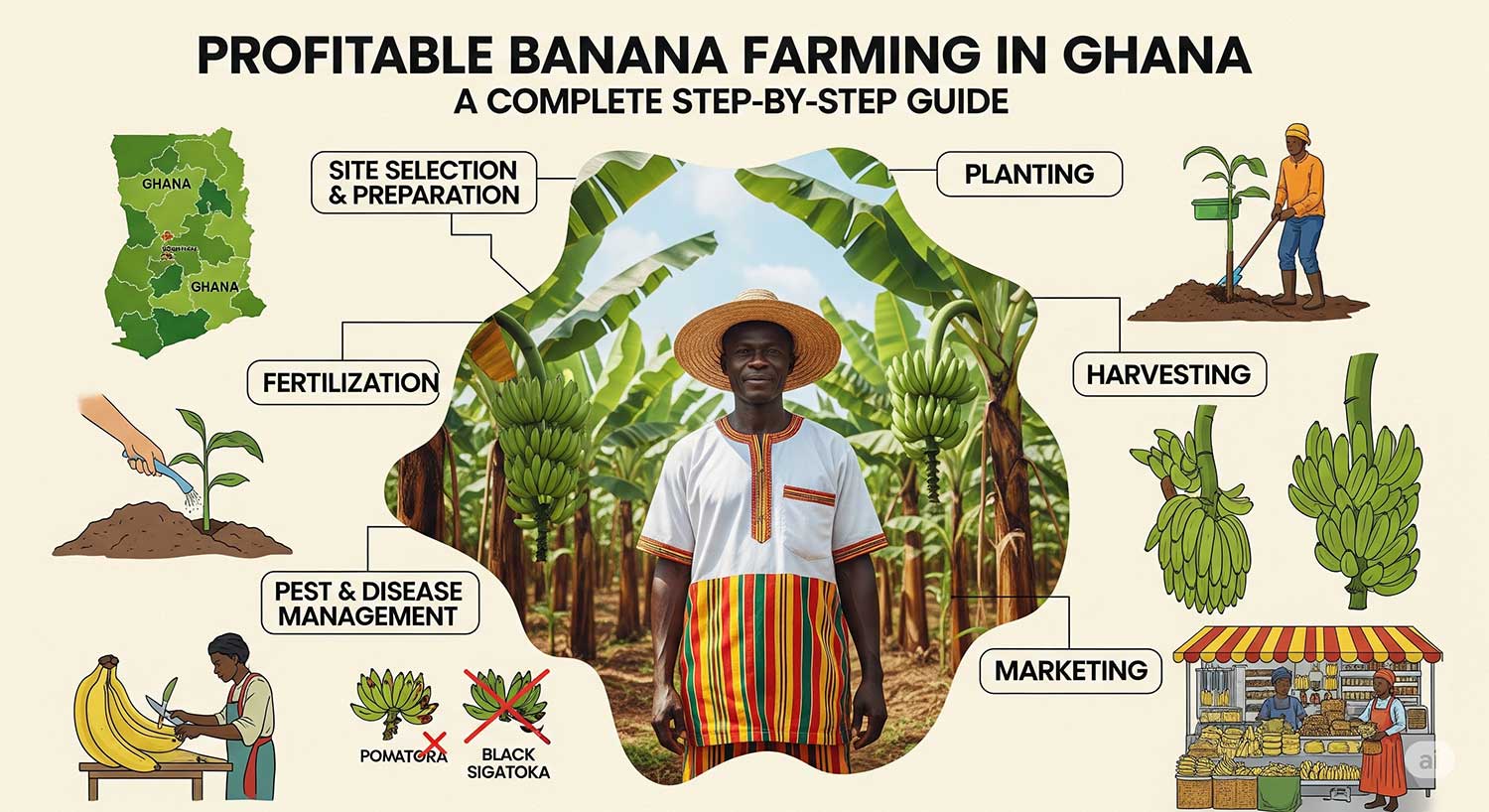Profitable Banana Farming in Ghana: A Complete Step-by-Step Guide
Ghana’s fertile lands and tropical climate present a golden opportunity for entrepreneurs in the agricultural sector. banana farming banana varieties in ghana, in particular, stands out as a highly lucrative venture, driven by strong local consumption and a rapidly growing export market. For any entrepreneur aiming to start a profitable banana farming venture in Ghana, a complete understanding of the process, from disease control and meeting market demand for urban centers and hotels, is the key to success. This guide provides a comprehensive, step-by-step roadmap for establishing and scaling a successful banana enterprise in Ghana.
Understanding the Market and Choosing the Right Banana Variety
Before planting a single sucker, it’s crucial to understand the market you intend to serve. Ghana’s banana industry caters to both a robust domestic market and a demanding international one. West and Central African countries, including Ghana, produce nearly all of Africa’s banana exports, with the majority sold in Europe.
- Local Markets: Plantains and sweet dessert bananas are staples in the Ghanaian diet. Local markets, urban centers, and roadside stalls offer a consistent outlet for produce.
- Export & High-Value Markets (Hotels, Supermarkets): These markets demand high-quality, unblemished fruit, often of the Cavendish variety. Traceability, sustainable practices, and certifications like Fairtrade can significantly increase your market access and profitability. Companies like Volta River Estates have demonstrated success by focusing on socially responsible, Fairtrade-certified production for European retailers.
Common Banana Varieties in Ghana
Selecting the right variety is critical and depends on your target market and local growing conditions.
- Cavendish: The most widely exported dessert banana. It’s popular for its long shelf life and resistance to some diseases, making it ideal for commercial, large-scale farming targeting international markets.
- Plantain (Apem & Apantu): A cooking banana that is a dietary staple in Ghana. It has a consistent and high local demand.
- Lady Finger Bananas: Smaller and sweeter than Cavendish, these are a popular dessert banana for local consumption.
- Bluggoe (ABB type): While present, this variety is highly susceptible to insect-vectored diseases and can increase risk on a farm if not managed properly.
A Step-by-Step Guide to Starting Your Banana Farm in Ghana
1. Business Planning and Research
Treat your farm as a business. Develop a detailed business plan that outlines your initial capital, operational costs (land, labour, inputs, electricity), target market, and projected revenue. Research local regulations, land acquisition processes, and potential access to credit or agricultural support programs.
2. Site Selection and Land Preparation
Bananas thrive in tropical regions with warm temperatures, high humidity, and consistent rainfall (78-98 inches annually). The ideal location in Ghana, especially for export, is in regions like the Lower Volta, which has established infrastructure.
- Soil: Choose rich, dark, fertile, and well-draining loamy soils. Poor drainage can lead to root rot.
- Land Prep: Clear the land of weeds and other vegetation. Plough the land thoroughly to create a fine tilth for optimal root development.
3. Planting and Spacing
Bananas are grown from suckers or rhizomes (bulbs), not seeds. It’s vital to source disease-free planting material from a reputable nursery or tissue culture lab to prevent introducing diseases like Fusarium Wilt from the start.
- Planting Season: The best time to plant in Ghana is during the rainy season (typically March to August) to ensure adequate moisture for the young plants.
- Spacing: Proper spacing is crucial for air circulation (reducing disease) and sunlight exposure. A common spacing is 3 meters by 3 meters, allowing for approximately 1,100 plants per hectare.
4. Farm Management: Irrigation, Fertilization, and Pruning
Consistent management is what separates a subsistence farm from a profitable enterprise.
- Irrigation: While Ghana has rainy seasons, a supplementary irrigation system is essential during dry spells to ensure the steady moisture that bananas require for continuous fruit production.
- Fertilization: Bananas are heavy feeders. Regular application of potassium-rich fertilizers is necessary to support healthy growth and high yields. Organic farming practices, using compost and manure, are increasingly in demand and can improve soil health.
- Pruning & Propping: Remove dead or dying leaves (de-leafing) to improve air circulation and reduce disease habitats. As the fruit bunch develops and becomes heavy, use wooden or bamboo poles to prop the plant and prevent it from toppling over.
Critical Disease and Pest Control in Ghanaian Banana Farming
Disease outbreaks can wipe out an entire plantation. Proactive disease management is non-negotiable for a sustainable business. High precipitation, which is common in Ghana’s banana-growing regions, can create a conducive environment for pathogens, making vigilance essential.
Key Diseases and Control Measures
| Disease | Symptoms & Impact | Control & Prevention Strategy |
|---|---|---|
| Xanthomonas Wilt (XW) | A devastating bacterial disease. Causes premature ripening, yellowing and wilting of leaves, and a bacterial ooze from cut stems. Can lead to 100% yield loss if unmanaged. Spreads rapidly via contaminated farm tools, insects, and infected planting material. | Use only certified disease-free planting materials. Sterilize farm tools (machetes, knives) between each plant using fire or bleach. Remove the male bud (de-budding) with a forked stick after the last fruit hand has formed to prevent insect transmission. Promptly remove and destroy infected plants. |
| Black Sigatoka | A fungal leaf spot disease that reduces the plant’s photosynthetic ability, leading to smaller bunches and premature ripening. Can reduce yields by up to 40% annually. | Proper spacing for air circulation, regular de-leafing of affected leaves, and application of approved fungicides. |
| Fusarium Wilt (Panama Disease TR4) | A soil-borne fungus that is a major threat to the global banana industry, particularly the Cavendish variety. Causes yellowing and collapse of leaves. It cannot be controlled with chemicals once the soil is infected. | The most critical control is prevention. Use clean, tissue-cultured planting material. Implement strict biosecurity on your farm (e.g., cleaning footwear and equipment) to prevent soil movement from other areas. |
| Banana Weevils | Pests that bore into the plant’s corm, weakening it and reducing nutrient uptake, which can cause the plant to fall over. | Use clean planting material and proper field sanitation. Trapping weevils can also help manage populations. |
Harvesting, Processing, and Tapping into High-Value Markets
The journey from farm to profit involves careful post-harvest handling. To successfully target urban markets and hotels in Ghana, consistency in quality and supply is paramount. These buyers require unbruised, aesthetically pleasing bananas.
- Harvesting: Bananas for export and distant markets are harvested while still green but fully mature (typically 9-12 months after planting). They are cut down in large bunches (stems) and must be handled carefully to prevent bruising.
- Packhouse Operations: At the packhouse, the bunches are de-handed, washed to remove latex and debris, sorted by quality, and graded by size. Bananas that don’t meet export standards can be sold on the local market.
- Packaging and Transport: For export, bananas are packed in cartons and transported in refrigerated ships (‘reefers’) at around 13.3°C to extend shelf life. When they reach their destination, they are moved to special ripening rooms where ethylene gas is used to trigger uniform ripening before they are sent to shops.
- Value Addition: Increase your revenue streams by processing lower-grade bananas into value-added products like banana chips, banana flour, or puree, which have a growing local and international demand.
The Economics: Costs, Challenges, and Profitability
Banana farming in Ghana can be very profitable, but requires a clear understanding of the financial landscape.
- Living Wages vs. Minimum Wage: The official minimum wage in Ghana is often significantly lower than a living wage. The Global Living Wage Coalition estimates a living wage for the Lower Volta peri-urban area (a key banana region) to be around GH₵3,609 per month (as of 2024). Paying fair wages, as practiced by Fairtrade-certified farms, can lead to a more stable, motivated workforce and access to premium markets.
- Operational Costs: Key costs include labour, inputs (fertilizer, pesticides), and utilities. As seen with cases like the Musahamat Banana Farm, interruptions in essentials like electricity can halt operations, highlighting the need for robust financial planning.
- Market Challenges: Farmers can face challenges from global price fluctuations, competition from large Latin American plantations, and high costs of inputs and transportation. Poor road infrastructure can also lead to significant post-harvest losses.
- Access to Finance: Smallholder farmers often struggle to access credit. Forming cooperatives can help pool resources, improve bargaining power, and gain better access to financing and markets.
Conclusion: Your Path to a Thriving Banana Business in Ghana
The Ghanaian banana sector is ripe with potential. By combining modern agricultural practices with smart business strategies, entrepreneurs can build a resilient and highly profitable enterprise. This complete step-by-step guide for entrepreneurs highlights that success hinges on a holistic approach: starting with disease-free plants, implementing rigorous disease control, understanding the specific demands of urban and export markets, and committing to fair and sustainable practices. With dedication and strategic planning, your banana farm can become a key contributor to Ghana’s agricultural success story, generating income, creating jobs, and feeding both local and global communities.











